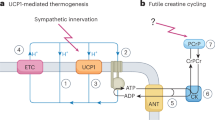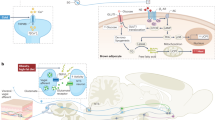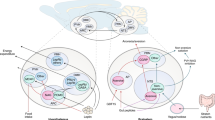Abstract
Much of our understanding about ‘adaptive thermogenesis’ as a control system in mammalian weight regulation derives from studies of experimental starvation and overfeeding, and these have served to characterize its functional role as an ‘attenuator’ of energy imbalance. By applying a system-analysis approach in evaluating data on the energetics of starvation and refeeding, evidence is presented here in support of the hypothesis that there are in fact two distinct control systems underlying adaptive thermogenesis. In one of them, the efferent limb is primarily under the control of the sympathetic nervous system (SNS), whose functional state is dictated by overlapping or interacting signals arising from a variety of environmental stresses, including food deprivation, deficiency of essential nutrients, excess energy intake and exposure to cold or to infections; it is hence referred to as the non-specific control of thermogenesis, and is likely to occur primarily in organs/tissues with a high specific metabolic rate (eg liver, kidneys, brown fat). The other is independent of the functional state of the SNS and is dictated solely by signals arising from the state of depletion of the adipose tissue fat stores; it is hence referred to as the adipose-specific control of thermogenesis, and is postulated to occur primarily in the skeletal muscle. While suppression of this adipose-specific thermogenesis during both starvation and refeeding leads to energy conservation, the energy spared during refeeding is directed specifically at the replenishment of the fat stores, so that it functions as an ‘accelerator’ of fat recovery. These two distinct control sytems for adaptive thermogenesis have been incorporated in a compartmental model of body weight and body composition regulation. This is used to provide a mechanistic explanation as to how, during weight recovery, they can operate simultaneously but in opposite directions—with activation of thermogenesis under non-specific control being energy-dissipating, while suppression of thermogenesis under adipose-specific control being energy-conserving—and could hence explain the paradox of a high efficiency of fat recovery co-existing with an overall state of enhanced thermogenesis and hypermetabolism. Elucidating the components of the adipose-specific control of thermogenesis (ie its sensors, signals and effector mechanisms) will have important implications for our understanding of body composition regulation, and hence for the development of more effective strategies in the management of cachexia and obesity.
This is a preview of subscription content, access via your institution
Access options
Subscribe to this journal
Receive 12 print issues and online access
$259.00 per year
only $21.58 per issue
Buy this article
- Purchase on Springer Link
- Instant access to full article PDF
Prices may be subject to local taxes which are calculated during checkout
Similar content being viewed by others
Author information
Authors and Affiliations
Corresponding author
Rights and permissions
About this article
Cite this article
Dulloo, A., Jacquet, J. An adipose-specific control of thermogenesis in body weight regulation. Int J Obes 25 (Suppl 5), S22–S29 (2001). https://doi.org/10.1038/sj.ijo.0801907
Published:
Issue Date:
DOI: https://doi.org/10.1038/sj.ijo.0801907
Keywords
This article is cited by
-
Fat as insurance, leanness as bodily display: did Ronald Reagan make us fat?
Journal of Bioeconomics (2023)
-
Deep transcranial magnetic stimulation in combination with skin thermography in obesity: a window on sympathetic nervous system
Acta Diabetologica (2022)
-
Collateral fattening in body composition autoregulation: its determinants and significance for obesity predisposition
European Journal of Clinical Nutrition (2018)
-
Finger skin temperatures in 8- to 11-year-old children: determinants including physical characteristics and seasonal variation. The Physical Activity and Nutrition in Children (PANIC) Study
European Journal of Applied Physiology (2016)
-
Greater Than Predicted Decrease in Resting Energy Expenditure and Weight Loss: Results From a Systematic Review
Obesity (2012)



